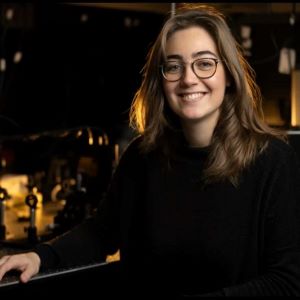Career Spotlight: PhD student Alice Ruget
Published: 16 November 2021
Read More
The team at QuantIC caught up with postdoctoral student, Alice Ruget, who is in the middle of her PhD at Heriot-Watt University in Edinburgh. Alice is focusing on implementing neural networks to enhance the image quality of single-photon sensitive detector (SPAD) arrays.
We wanted to know more about her PhD journey so far, and the societal applications her research is enabling.
Your background was in Biomedical Engineering, how did you end up in the National Quantum Technologies Programme?
During my masters in Biomedical engineering, I specialized in bio-imaging and got particularly interested in computational imaging and post-processing techniques to extract the best information from raw data. For example, during my master thesis, I studied machine learning approaches to be able to reconstruct fast acquired MRI data. After my masters, I applied for a PhD position in the group HWQuantum at Heriot-Watt to continue working on computational imaging but for different types of data such as lidar. In the National Quantum Technologies Programme, I am now implementing neural networks to enhance the image quality of single-photon sensitive detector (SPAD) arrays.
Can you explain what your research focus is with Heriot Watt?
I am developing neural networks to create a 3D representation of scenes and objects from different types of detectors using technology such as lidar, radar, or classic RGB images. My first project consisted of developing a neural network to increase the resolution of general depth images using a SPAD camera. Currently, I am finishing a project that reconstructs poses of people using a very small and (apparently) low-resolution lidar sensor with neural networks. I like to explore how much information we can actually extract from apparent bad data via neural networks. There is often more than meets the eye!
What are the societal applications of this research, what would this enable?
3D reconstruction of scenes has a wide range of applications, such as virtual reality for smartphones or obstacle detection in self-driving cars. I think it is also interesting to see that data often contains much richer information than what we think, especially if processed by neural networks. For example, I was really impressed to see the high-resolution reconstruction of people that neural networks could achieve from wifi signal only (Zhao et al. Through-Wall Human Pose Estimation Using Radio Signals ), or how many spatial structures we can see from a single pixel SPAD sensor (Turpin et al. Spatial images from temporal data ). As deep learning starts to have applications in important domains such as medicine and military and, in general, with regards to privacy and surveillance issues, I think it is relevant to understand what is achievable with neural networks and also their limitations.
What inspired you to join the team at Heriot-Watt University?
The group was very friendly with a good team spirit and was very active and dynamic in many different projects and collaborations. I was very interested as well in this group because the PhD students were working on a variety of subjects in quantum optics that I knew very little about: light-in-flight imaging, single photon detectors or optical communication, and were mainly doing experimental physics. I thought it would be very nice and it would benefit me to discover this side of physics, as my background was mainly computational based.
What advice would you give to another student who is considering joining the NQTP with a PhD?
I think doing a PhD gives a great opportunity to lead your own project within a structure that gives a lot of support and help. I found it really nice to be surrounded by scientists working on a variety of projects and from all over the world. A helpful piece of advice that I received when I started was to try to produce something as quickly as possible, even if it is not in the most elegant way. I found that having this in mind enables me to have an active approach in the work. Moreover, the amount of already published work and papers can be overwhelming, and trying to get things done at the same time enables to narrow down the literature to the relevant information for a specific project.
What comes next for you?
I am now halfway through the PhD, with still 2 years to go. My next project will consist on developing neural networks to reconstruct 3D scenes from radar data. Radar data is interesting because it can gather information at a very long range and it is also not affected by weather conditions such as fog, although it has seemingly quite a low spatial resolution.
Click here to find out more about PhD studentships with QuantIC and the National Quantum Technologies Programme.
First published: 16 November 2021
HWQuantum led by Professor Jonathan Leach at Heriot-Watt University, Edinburgh


